The ASUS ROG Strix Z370-F Gaming Review: A $200 Motherboard at 5.1 GHz
by Joe Shields on October 1, 2018 8:00 AM EST- Posted in
- Motherboards
- Asus
- ROG
- M.2
- USB 3.1
- Strix
- Coffee Lake
- i7-8700K
- Z370-F Gaming
- SupremeFX
Visual Inspection
When looking at the Z370-F Gaming from ASUS we are presented with a matte black PCB, all black connectors and grey brushed aluminum heatsinks all around. There is a corner to corner motif design for some 'flair', if that's a thing. This is a much better aesthetic than the previous ASUS board reviewed with all the ROG branding on the board and will provide a more neutral aesthetic overall.
The Z370-F Gaming does include RGB LEDs for additional lighting, and some are found on the rear IO cover just above one of the power delivery heatsinks. The RGB LED shines through a piece of frosted plastic which gives the area a nice glow without being able to see the individual LEDs (when looking at it from above). The integrated lighting is controlled through the AURA software as well as any attached to the onboard RGB LED headers (2x 4-pin and one addressable RGB header).
For cooling, the board includes a total of six fan headers located in various locations on the board. In the top right corner by the DRAM slots and the edge of the board, users will find two CPU headers and a chassis fan (CPU fan supports 1A max). Just above the top PCIe x1 slot are a second chassis fan and AIO_Pump fan. Across the bottom of the board is the sixth fan header ASUS has labeled M.2 fan. There is also a 5-pin EXT fan header which supports 2 of 5 thermal sensor sources. Attached fans can be controlled through the UEFI or through AI Suite 3 and the FanExpert 4 section.
The power delivery setup used on the Z370-F Gaming uses the DIGI+ ASP1400BT controller unique to ASUS. The controller is able to handle four phases for the CPU and two for the integrated GPU. High side duties are managed by SiRA14DP (58A) MOSFETs with the low side using SiRA12DP (60A). The power delivery system has large heatsinks covering the power bits to help keep the cool under load and especially while overclocking. With this cooling, users shouldn't see any power delivery issues.
| Z370 Motherboard VRM Comparison | ||||||
| Motherboard | Controller | H-Side | L-Side | Chokes | Doubler | |
| ASUS | ||||||
| Z370-F Gaming | ASP1400BT | 4+2 | SiRA14DP | SiRA12DP | 10 | - |
| Z370 Apex | ASP1405I | 4+2 | BSG0812ND | 10 | IR3599 | |
| Z370-I Gaming | ASP1400BT | 4+2 | 4C86N | 8 | - | |
| ASRock | ||||||
| Z370 Taichi | ISL69138 | 5+2 | Fairchild DPC50309 | 8 | - | |
| Z370 Gaming ITX/ac | ISL69138 | 5+2 | ISL99227B | 8 | - | |
| MSI | ||||||
| Z370-A Pro | uP9508Q | 3+2 | SM4337 | ? | 6 | - |
| Z370I Gaming Pro Carbon AC |
iP9508 | 3+2 | QM3816 | 8 | uP1961 | |
| Others | ||||||
| NZXT Z370 | IR35201 | 7+1 | BSG0812ND | 15 | IR3598 | |
| SuperMicro C7Z370-CG-IW |
MP2955G | 4+2 | MP86908 | 6 | - | |
The table above displays the Z370 boards we have reviewed so far and lists the power delivery hardware including the controller, MOSFETs (both High and Low side where applicable), number of chokes, and phase doublers (if applicable).
The right side of the board has a fair amount going on with it. On the left side, we are able to see three stacks of SATA ports (totaling 6 ports) along with a horizontally oriented USB 3.0 header. Sliding over to the right we can see the four single-latch DRAM slots and just below them is the 24-pin ATX power connector. In the right corner, to the right of the mount hole, we are able to see a couple of LEDs which provide the status of key components during POST. This includes the CPU, memory modules, VGA card, and disk drives. If one of these components are causing an issue during POST, the LED will light up showing the user where the issue may be. Since the board does not have a debug display, these can help identify where the issue is quicker.
Zooming in on the SATA ports we can see all six and the USB 3.0 port more closely. The board supports RAID 0, 1, 5, and 10. When using the top M.2 slot closest to the CPU, it shares SATA ports 5/6 when using an M.2 device in PCIe x4 mode. The lower slot (M.2_1) shares SATA port 1 when using an M.2 device in SATA mode.
The bottom half of the board also has a lot going on, at least more than the Mini-ITX sized boards we have reviewed lately anyway. The left side holds all the audio goodies, from the S1220A Supreme FX codecs under the audio cover, to dual Op Amps capable of driving a wide range of headphones from 32-600Ω. The board uses Nichicon Japanese capacitors which ASUS claims to produce a warmer, natural sound.
In the PCIe area, we are able to see seven total PCIe slots - 3 full-length, and four x1 size slots. Two of the full-length slots, intended for video cards, are reinforced using ASUS' Safeslot for improved retention force shearing. Both of the full-length reinforced slots are connected through the CPU while the remainder are connected through the chipset. With this configuration, the board supports both Crossfire and SLI multi-GPU technologies (3-way in the case of Crossfire).
Below is a quick reference table to show how the PCIe lanes are split out for various configurations. The "@" symbol is used to show slot preference for the configuration.
| ASUS ROG Strix Z370-F Gaming CPU PCIe Layout | |||
| 16-Lane Single |
16-Lane Dual |
16-Lane 3-Way |
|
| PCIe 2 | @x16 | @x8 | @x8 |
| PCIe 5 | - | @x8 | @x8 |
| PCIe 7 (from PCH) | - | - | @x4 |
| SLI | - | Yes | No |
| Crossfire | - | Yes | Yes |
The back panel IO contains modern connectivity including USB 3.1 (10 Gbps) Type-A and Type-C ports, with USB 3.0, and USB 2.0 ports rounding out USB support. The board also offers users multiple video outputs in the form of DVI-D, HDMI, and DisplayPort 1.2 ports for using the integrated video card in the processors. We can also see an audio stack with S/PDIF as well as an RJ-45 port.
- 1 x DVI-D
- 1 x DisplayPort
- 1 x HDMI
- 1 x LAN (RJ45) port
- 2 x USB 3.1 (10 Gbps) Type-A and Type-C
- 2 x USB 3.0
- 2 x USB 2.0
- Optical S/PDIF out
- 5 x Audio jacks
In the Box
The ASUS Z370-F Gaming includes more accessories than we are used to seeing, including temperature probes, zip ties, and a CPU installation tool. The more common accessories are also included, such as SATA cables, driver disk, and the manual.
- Users Manual, Driver Disk, Door hanger, stickers
- 1 x ASUS fan holder
- 4 x SATA cables
- 1 x M.2 screws
- 1 x CPU installation tool
- 1 x SLI HB bridge
- 1 x Cable tie pack
- 1 x Extension cable for RGB strips (80cm)
- 1 x Extension cable for Addressable LED
- 1 x Thermistor cable
- 1 x 3D printing mount package



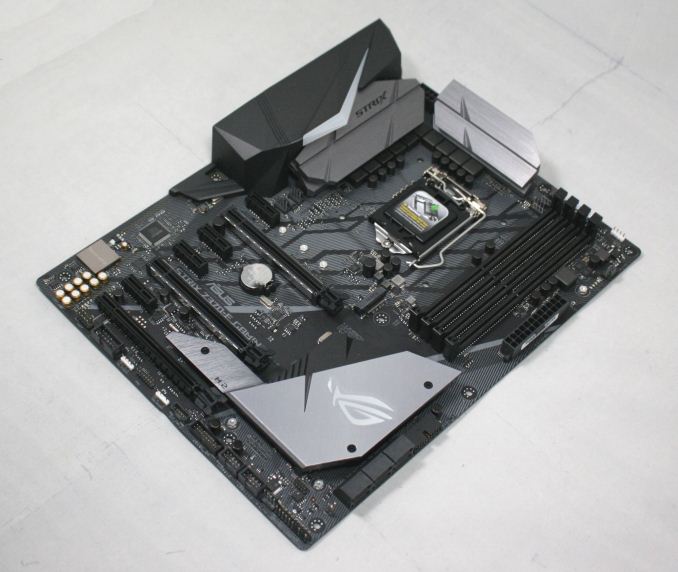
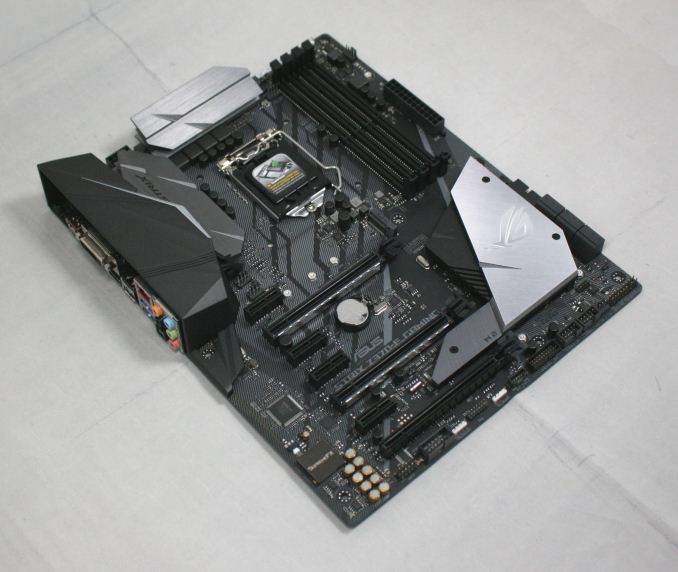
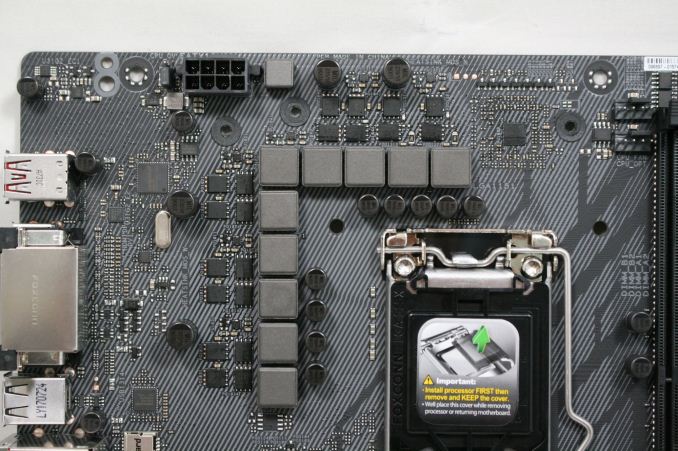
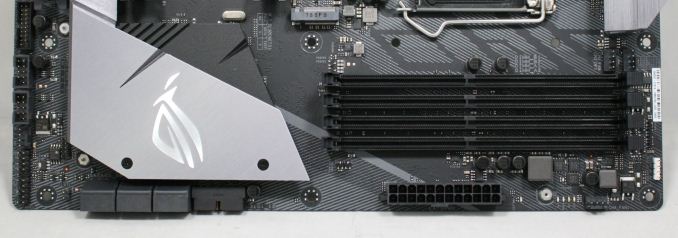
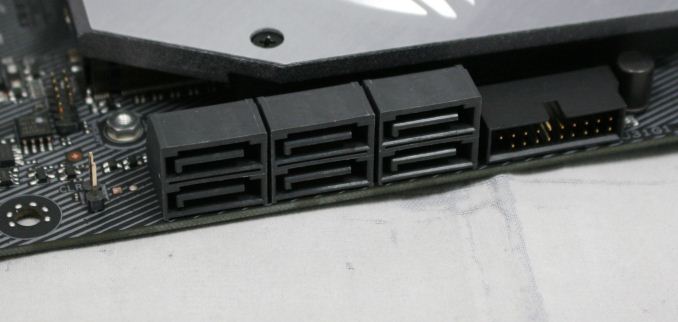
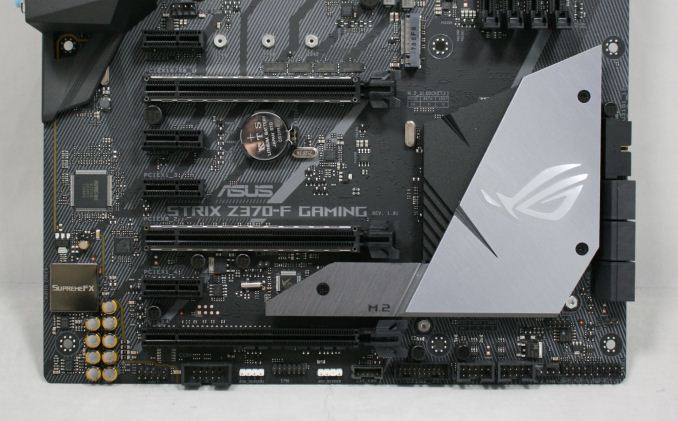

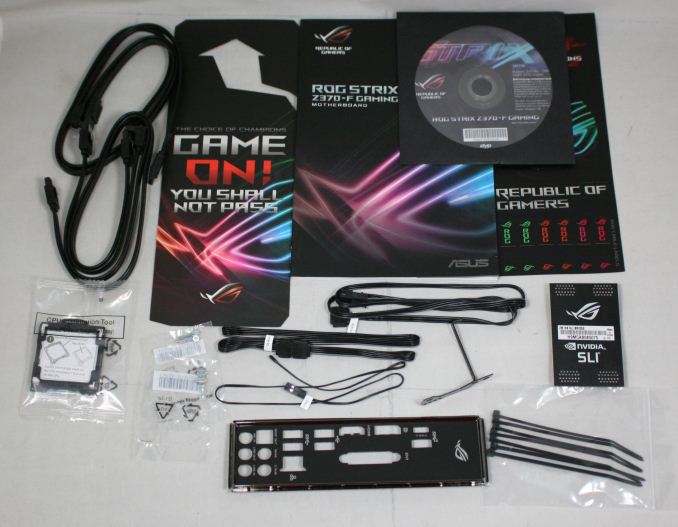














4 Comments
View All Comments
sniperganso - Monday, October 1, 2018 - link
There is a mistake in the "Overclocking page", it says "ASRock Z370-F" instead of "ASUS Z370-F"CarlosR - Monday, October 1, 2018 - link
Has anybody tested the performance with more than 1 M.2 PCIe SSD while simultaneous access of data? I am not sure how the line sharing is affecting the performance.dakishimesan - Monday, October 1, 2018 - link
This is the motherboard I have in my system. Each m.2 slot Can be used in x4 mode, but when you do so with both of them it disables sata ports five and six.prateekprakash - Monday, October 1, 2018 - link
Could you please confirm if the HDMI port is 2.0? Then it may support DRM to play uhd...